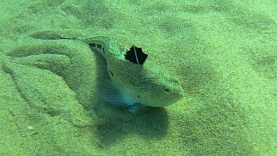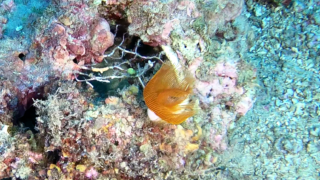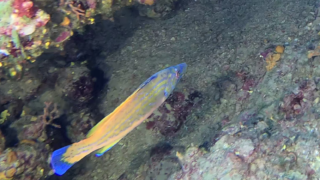Marine Plastic Pollution
While sailing to reach the place of diving I came across an expanded polystyrene box, the kind used by fishermen to transport fish, which floated in the sea.
In chemical terms, polystyrene is a long chain hydrocarbon wherein alternating carbon centers are attached to phenyl groups (a derivative of benzene). Polystyrene’s chemical formula is (C8H8); it contains the chimical elements carbon and hydrogen.
The material’s properties are determined by short-range van der Waals attractions between polymers chains. Since the molecules consist of thousands of atoms, the cumulative attractive force between the molecules is large. When heated (or deformed at a rapid rate, due to a combination of viscoelastic and thermal insulation properties), the chains are able to take on a higher degree of conformation and slide past each other. This intermolecolar weakness (versus the high intramolecular strength due to the hydrocarbon backbone) confers flexibility and elasticity. The ability of the system to be readily deformed above its glass transition temperature allows polystyrene (and thermoplastic polymers in general) to be readily softened and molded upon heating. Extruded polystyrene is about as strong as an unalloyed aluminium but much more flexible and much less dense (1.05 g/cm3 for polystyrene vs. 2.70 g/cm3 for aluminium).
Expanded polystyrene (EPS) is a rigid and tough, closed-cell foam with a normal density range of 11 to 32 kg/m3. It is usually white and made of pre-expanded polystyrene beads. EPS is used for food containers, molded sheets for building isulation , and packing material either as solid blocks formed to accommodate the item being protected or as loose-fill “peanuts” cushioning fragile items inside boxes. A significant portion of all EPS products are manufactured through injection molding. Mold tools tend to be manufactured from steels (which can be hardened and plated), and aluminum alloys. The molds are controlled through a split via a channel system of gates and runners. EPS is colloquially called “styrofoam” in the United States and Canada, an incorrectly applied generization of Dow Chemical’s brand of estruded polystyrene.

I collected this refusal to prevent it from polluting the sea but, to my surprise, I realized that the polystyrene box had been “attacked” by marine animals; probably fish, or mammals like dolphins, or from the loggerhead turtle. The video and the photographs you are seeing show very clearly the imprints left by the teeth of the animals that surely have confused the polystyrene box for a large jellyfish or something else edible.
Greta Thunberg, Swedish activist for sustainable development is inviting young people from all over the world, and the governments of various countries, to commit themselves to safeguarding the future of planet Earth, that is, the home of all the living beings that are part of it, and therefore also of the great marine ecosystem put in serious difficulties because of pollution in general and pollution of plastics in particular.
The site www.intotheblue.it has often shown videos and images on the effects that climate change and pollution produce on the marine ecosystem, inviting everyone to take an active role in our small daily actions. It is now clear to everyone that plastics and microplastics enter the food chain of fish and marine organisms and consequently in the food chain also of man as a final consumer; with serious repercussions on health and quality of life.





















You must be logged in to post a comment.